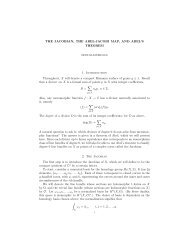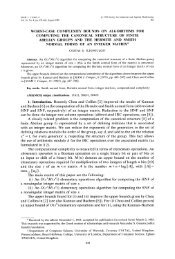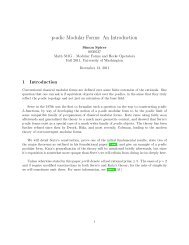- Page 1 and 2: Introductory Differential Equations
- Page 4 and 5: Contents 1 First order differential
- Page 6 and 7: CONTENTS ix 4.3.3 Explanation . . .
- Page 8 and 9: xii CONTENTS answer_table = [] answ
- Page 10 and 11: 2 CONTENTS
- Page 12 and 13: 4 CHAPTER 1. FIRST ORDER DIFFERENTI
- Page 14 and 15: 6 CHAPTER 1. FIRST ORDER DIFFERENTI
- Page 16 and 17: 8 CHAPTER 1. FIRST ORDER DIFFERENTI
- Page 18 and 19: 10 CHAPTER 1. FIRST ORDER DIFFERENT
- Page 20 and 21: 12 CHAPTER 1. FIRST ORDER DIFFERENT
- Page 24 and 25: 16 CHAPTER 1. FIRST ORDER DIFFERENT
- Page 26 and 27: 18 CHAPTER 1. FIRST ORDER DIFFERENT
- Page 28 and 29: 20 CHAPTER 1. FIRST ORDER DIFFERENT
- Page 30 and 31: 22 CHAPTER 1. FIRST ORDER DIFFERENT
- Page 32 and 33: 24 CHAPTER 1. FIRST ORDER DIFFERENT
- Page 34 and 35: 26 CHAPTER 1. FIRST ORDER DIFFERENT
- Page 36 and 37: 28 CHAPTER 1. FIRST ORDER DIFFERENT
- Page 38 and 39: 30 CHAPTER 1. FIRST ORDER DIFFERENT
- Page 40 and 41: 32 CHAPTER 1. FIRST ORDER DIFFERENT
- Page 42 and 43: 34 CHAPTER 1. FIRST ORDER DIFFERENT
- Page 44 and 45: 36 CHAPTER 1. FIRST ORDER DIFFERENT
- Page 46 and 47: 38 CHAPTER 1. FIRST ORDER DIFFERENT
- Page 48 and 49: 40 CHAPTER 1. FIRST ORDER DIFFERENT
- Page 50 and 51: 42 CHAPTER 1. FIRST ORDER DIFFERENT
- Page 52 and 53: 44 CHAPTER 1. FIRST ORDER DIFFERENT
- Page 54 and 55: 46 CHAPTER 1. FIRST ORDER DIFFERENT
- Page 56 and 57: 48 CHAPTER 1. FIRST ORDER DIFFERENT
- Page 58 and 59: 50 CHAPTER 1. FIRST ORDER DIFFERENT
- Page 60 and 61: 52 CHAPTER 1. FIRST ORDER DIFFERENT
- Page 62 and 63: 54 CHAPTER 1. FIRST ORDER DIFFERENT
- Page 64 and 65: 56 CHAPTER 1. FIRST ORDER DIFFERENT
- Page 66 and 67: 58 CHAPTER 2. SECOND ORDER DIFFEREN
- Page 68 and 69: 60 CHAPTER 2. SECOND ORDER DIFFEREN
- Page 70 and 71: 62 CHAPTER 2. SECOND ORDER DIFFEREN
- Page 72 and 73:
64 CHAPTER 2. SECOND ORDER DIFFEREN
- Page 74 and 75:
66 CHAPTER 2. SECOND ORDER DIFFEREN
- Page 76 and 77:
68 CHAPTER 2. SECOND ORDER DIFFEREN
- Page 78 and 79:
70 CHAPTER 2. SECOND ORDER DIFFEREN
- Page 80 and 81:
72 CHAPTER 2. SECOND ORDER DIFFEREN
- Page 82 and 83:
74 CHAPTER 2. SECOND ORDER DIFFEREN
- Page 84 and 85:
76 CHAPTER 2. SECOND ORDER DIFFEREN
- Page 86 and 87:
78 CHAPTER 2. SECOND ORDER DIFFEREN
- Page 88 and 89:
80 CHAPTER 2. SECOND ORDER DIFFEREN
- Page 90 and 91:
82 CHAPTER 2. SECOND ORDER DIFFEREN
- Page 92 and 93:
84 CHAPTER 2. SECOND ORDER DIFFEREN
- Page 94 and 95:
86 CHAPTER 2. SECOND ORDER DIFFEREN
- Page 96 and 97:
88 CHAPTER 2. SECOND ORDER DIFFEREN
- Page 98 and 99:
90 CHAPTER 2. SECOND ORDER DIFFEREN
- Page 100 and 101:
92 CHAPTER 2. SECOND ORDER DIFFEREN
- Page 102 and 103:
94 CHAPTER 2. SECOND ORDER DIFFEREN
- Page 104 and 105:
96 CHAPTER 2. SECOND ORDER DIFFEREN
- Page 106 and 107:
98 CHAPTER 2. SECOND ORDER DIFFEREN
- Page 108 and 109:
100 CHAPTER 2. SECOND ORDER DIFFERE
- Page 110 and 111:
102 CHAPTER 2. SECOND ORDER DIFFERE
- Page 112 and 113:
104 CHAPTER 2. SECOND ORDER DIFFERE
- Page 114 and 115:
106 CHAPTER 2. SECOND ORDER DIFFERE
- Page 116 and 117:
108 CHAPTER 2. SECOND ORDER DIFFERE
- Page 118 and 119:
110 CHAPTER 2. SECOND ORDER DIFFERE
- Page 120 and 121:
112 CHAPTER 2. SECOND ORDER DIFFERE
- Page 122 and 123:
114 CHAPTER 2. SECOND ORDER DIFFERE
- Page 124 and 125:
116 CHAPTER 2. SECOND ORDER DIFFERE
- Page 126 and 127:
118 CHAPTER 3. MATRIX THEORY AND SY
- Page 128 and 129:
120 CHAPTER 3. MATRIX THEORY AND SY
- Page 130 and 131:
122 CHAPTER 3. MATRIX THEORY AND SY
- Page 132 and 133:
124 CHAPTER 3. MATRIX THEORY AND SY
- Page 134 and 135:
126 CHAPTER 3. MATRIX THEORY AND SY
- Page 136 and 137:
128 CHAPTER 3. MATRIX THEORY AND SY
- Page 138 and 139:
130 CHAPTER 3. MATRIX THEORY AND SY
- Page 140 and 141:
132 CHAPTER 3. MATRIX THEORY AND SY
- Page 142 and 143:
134 CHAPTER 3. MATRIX THEORY AND SY
- Page 144 and 145:
136 CHAPTER 3. MATRIX THEORY AND SY
- Page 146 and 147:
138 CHAPTER 3. MATRIX THEORY AND SY
- Page 148 and 149:
140 CHAPTER 3. MATRIX THEORY AND SY
- Page 150 and 151:
142 CHAPTER 3. MATRIX THEORY AND SY
- Page 152 and 153:
144 CHAPTER 3. MATRIX THEORY AND SY
- Page 154 and 155:
146 CHAPTER 3. MATRIX THEORY AND SY
- Page 156 and 157:
148 CHAPTER 3. MATRIX THEORY AND SY
- Page 158 and 159:
150 CHAPTER 3. MATRIX THEORY AND SY
- Page 160 and 161:
152 CHAPTER 3. MATRIX THEORY AND SY
- Page 162 and 163:
154 CHAPTER 3. MATRIX THEORY AND SY
- Page 164 and 165:
156 CHAPTER 3. MATRIX THEORY AND SY
- Page 166 and 167:
158 CHAPTER 3. MATRIX THEORY AND SY
- Page 168 and 169:
160 CHAPTER 3. MATRIX THEORY AND SY
- Page 170 and 171:
162 CHAPTER 3. MATRIX THEORY AND SY
- Page 172 and 173:
164 CHAPTER 3. MATRIX THEORY AND SY
- Page 174 and 175:
166 CHAPTER 3. MATRIX THEORY AND SY
- Page 176 and 177:
168 CHAPTER 3. MATRIX THEORY AND SY
- Page 178 and 179:
170 CHAPTER 3. MATRIX THEORY AND SY
- Page 180 and 181:
172 CHAPTER 3. MATRIX THEORY AND SY
- Page 182 and 183:
174 CHAPTER 3. MATRIX THEORY AND SY
- Page 184 and 185:
176 CHAPTER 4. INTRODUCTION TO PART
- Page 186 and 187:
178 CHAPTER 4. INTRODUCTION TO PART
- Page 188 and 189:
180 CHAPTER 4. INTRODUCTION TO PART
- Page 190 and 191:
182 CHAPTER 4. INTRODUCTION TO PART
- Page 192 and 193:
184 CHAPTER 4. INTRODUCTION TO PART
- Page 194 and 195:
186 CHAPTER 4. INTRODUCTION TO PART
- Page 196 and 197:
188 CHAPTER 4. INTRODUCTION TO PART
- Page 198 and 199:
190 CHAPTER 4. INTRODUCTION TO PART
- Page 200 and 201:
192 CHAPTER 4. INTRODUCTION TO PART
- Page 202 and 203:
194 CHAPTER 4. INTRODUCTION TO PART
- Page 204 and 205:
196 CHAPTER 4. INTRODUCTION TO PART
- Page 206 and 207:
198 CHAPTER 4. INTRODUCTION TO PART
- Page 208 and 209:
200 CHAPTER 4. INTRODUCTION TO PART
- Page 210 and 211:
202 BIBLIOGRAPHY [D-spr] Wikipedia
- Page 212 and 213:
204 BIBLIOGRAPHY [NS-intro] General
- Page 214 and 215:
206 BIBLIOGRAPHY
- Page 216 and 217:
208 CHAPTER 5. APPENDICES 5.1 Appen
- Page 218 and 219:
210 CHAPTER 5. APPENDICES ∫ ∫
- Page 220 and 221:
212 CHAPTER 5. APPENDICES ∫ ∫
- Page 222:
214 CHAPTER 5. APPENDICES ∫ ∫ s

















